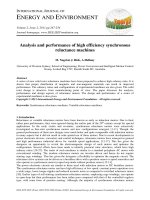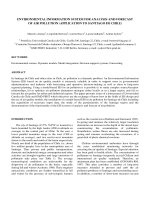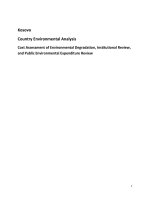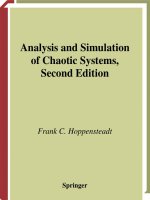- Trang chủ >>
- Khoa Học Tự Nhiên >>
- Vật lý
analysis and stochastics of growth processes and interface models oct 2008
Bạn đang xem bản rút gọn của tài liệu. Xem và tải ngay bản đầy đủ của tài liệu tại đây (3.47 MB, 347 trang )
Analysis and Stochastics of Growth Processes and
Interface Models
This page intentionally left blank
Analysis and Stochastics of Growth
Processes and Interface Models
Edited by
Peter M¨orters, Roger Moser, Mathew Penrose,
Hartmut Schwetlick, and Johannes Zimmer
1
3
Great Clarendon Street, Oxford OX2 6DP
Oxford University Press is a department of the University of Oxford.
It furthers the University’s objective of excellence in research, scholarship,
and education by publishing worldwide in
Oxford New York
Auckland Cape Town Dar es Salaam Hong Kong Karachi
Kuala Lumpur Madrid Melbourne Mexico City Nairobi
New Delhi Shanghai Taipei Toronto
With offices in
Argentina Austria Brazil Chile Czech Republic France Greece
Guatemala Hungary Italy Japan Poland Portugal Singapore
South Korea Switzerland Thailand Turkey Ukraine Vietnam
Oxford is a registered trade mark of Oxford University Press
in the UK and in certain other countries
Published in the United States
by Oxford University Press Inc., New York
c
Oxford University Press 2008
The moral rights of the authors have been asserted
Database right Oxford University Press (maker)
First Published 2008
All rights reserved. No part of this publication may be reproduced,
stored in a retrieval system, or transmitted, in any form or by any means,
without the prior permission in writing of Oxford University Press,
or as expressly permitted by law, or under terms agreed with the appropriate
reprographics rights organization. Enquiries concerning reproduction
outside the scope of the above should be sent to the Rights Department,
Oxford University Press, at the address above
You must not circulate this book in any other binding or cover
and you must impose the same condition on any acquirer
British Library Cataloguing in Publication Data
Data available
Library of Congress Cataloging in Publication Data
Data available
Typeset by Newgen Imaging Systems (P) Ltd., Chennai, India
Printed in Great Britain
on acid-free paper by
Biddles Ltd., King’s Lynn, Norfolk
ISBN 978–0–19–923925–2
13579108642
PREFACE
A regional meeting of the London Mathematical Society, followed by a work-
shop on ‘Analysis and Stochastics of Growth Processes’, was held at the Uni-
versity of Bath on 11–15 September 2006. The aim of these events was to bring
together analysts and probabilists working on the mathematical description of
growth phenomena, with models based on the physics of individual particles dis-
cussed alongside models based on the continuum description of large collections of
particles.
Convinced by positive feedback from the participants that this exercise in
interdisciplinary exchange was worthwhile, we invited the speakers of the meet-
ing and the workshop to contribute to this volume with an article in the same
spirit. We hope that the resulting collection will help bridge the gap between
researchers studying phenomena of the same type with different approaches. The
meeting and the workshop were funded by the London Mathematical Society and
the Bath Institute for Complex Systems, whose generous support is gratefully
acknowledged.
The Editors, Bath, 26th October 2007.
This page intentionally left blank
CONTENTS
List of Contributors ix
Introduction 1
PART I QUANTUM AND LATTICE MODELS
A Quantum and Lattice Models 7
1 Directed random growth models on the plane 9
Timo Sepp¨al¨ainen
2 The pleasures and pains of studying the two-type
Richardson model 39
Maria Deijfen and Olle H¨aggstr¨om
3 Ballistic phase of self-interacting random walks 55
Dmitry Ioffe and Yvan Velenik
B Microscopic to Macroscopic Transition 81
4 Stochastic homogenization and energy of infinite sets of points 83
Xavier Blanc
5 Validity and non-validity of propagation of chaos 101
Karsten Matthies and Florian Theil
C Applications in Physics 121
6 Applications of the lace expansion to statistical-mechanical
models 123
Akira Sakai
7 Large deviations for empirical cycle counts of integer
partitions and their relation to systems of Bosons 148
Stefan Adams
8 Interacting Brownian motions and the Gross–Pitaevskii formula 173
Stefan Adams and Wolfgang K¨onig
9 A short introduction to Anderson localization 194
Dirk Hundertmark
viii Contents
PART II MICROSCOPIC MODELS
A Nucleation and Growth 221
10 Effective theories for Ostwald ripening 223
Barbara Niethammer
11 Switching paths for Ising models with long-range
interaction 244
Nicolas Dirr
12 Nucleation and droplet growth as a stochastic process 265
Oliver Penrose
B Applications in Physics 279
13 On the stochastic Burgers equation with some applications to
turbulence and astrophysics 281
A. D. Neate and A. Truman
14 Liquid crystals and harmonic maps in polyhedral domains 306
Apala Majumdar, Jonathan Robbins, and Maxim Zyskin
Index 327
LIST OF CONTRIBUTORS
Stefan Adams
Mathematics Institute
Zeeman Building
University of Warwick
Coventry CV4 7AL
United Kingdom
Xavier Blanc
Laboratoire Jacques-Louis Lions
Universit´e Pierre et Marie Curie
- Paris 6
Boîte courrier 187
4, Place Jussieu
75252 Paris cedex 05
France
Maria Deijfen
Department of Mathematics
Stockholm University
106 91 Stockholm
Sweden
Nicolas Dirr
Department of Mathematical
Sciences
University of Bath
Bath BA2 7AY
United Kingdom
Olle H¨aggstr¨om
Mathematical Statistics
Chalmers University of Technology
S-412 96 G¨oteborg
Sweden
Dirk Hundertmark
Department of Mathematics
University of Illinois at
Urbana-Champaign
1409 W. Green Street (MC-382)
Urbana
Illinois 61801
United States of America
Dmitry Ioffe
William Davidson Faculty of
Industrial Engineering and
Management
Technion - Israel Institute
of Technology
Haifa 3200
Israel
Wolfgang K¨onig
Fakult¨at f¨ur Mathematik
und Informatik
Mathematisches Institut
Abteilung Wirtschaftsmathematik/
Stochastik
Postfach 10 09 20
D-04009 Leipzig
Germany
Apala Majumdar
Mathematical Institute
University of Oxford
24-29 St Giles’
Oxford OX1 3LB
United Kingdom
x List of Contributors
Karsten Matthies
Department of Mathematical
Sciences
University of Bath
Bath BA2 7AY
United Kingdom
Andrew Neate
Department of Mathematics
University of Wales Swansea
Singleton Park
Swansea SA2 8PP
United Kingdom
Barbara Niethammer
Mathematical Institute
University of Oxford
24-29 St Giles’
Oxford OX1 3LB
United Kingdom
Oliver Penrose
Heriot-Watt University
School of Mathematical and
Computer Sciences
Edinburgh EH14 4AS
United Kingdom
Jonathan Robbins
Department of Mathematics
University of Bristol
University Walk
Bristol BS8 1TW
United Kingdom
Akira Sakai
Creative Research Initiative Sousei
Hokkaido University
North 21, West 10, Kita-ku
Sapporo 001-0021
Japan
Timo Sepp¨al¨ainen
419 Van Vleck Hall
University of Wisconsin-Madison
Madison WI 53706-1388
United States of America
Florian Theil
Mathematics Institute
Zeeman Building
University of Warwick
Coventry CV4 7AL
United Kingdom
Aubrey Truman
Department of Mathematics
University of Wales Swansea
Singleton Park
Swansea SA2 8PP
United Kingdom
Yvan Velenik
Section de Math´ematiques
Universit´e de Gen`eve
2-4, rue du Li`evre
Case postale 64
1211 Gen`eve 4
Switzerland
Maxim Zyskin
Department of Mathematics
University of Texas
SETB 2.454 - 80 Fort Brown
Brownsville
TX 78520
USA
INTRODUCTION
There has been a significant increase recently in activities on the interface between
analysis and probability. Considering the potential of a combined approach to
the study of various physical systems, it seems likely that this trend will con-
tinue. Yet any attempt to cross the divide between different communities can be
impeded by the lack of a common vocabulary, or more fundamentally, by a lack
of awareness of developments in each other’s fields.
Against this background, the invited speakers of the London Mathematical
Society South West and South Wales regional meeting on ‘Analysis and Stochas-
tics of Growth Processes’, held at the University of Bath on 11–15 September
2006, provided an excellent example of how stimulating the interaction between
different communities can be. Many of them agreed to follow up this occasion
with a contribution to these proceedings, and were joined in some cases by co-
authors not present at the workshop. The result is a collection of articles, mainly
of survey character, covering a range of topics in deterministic and stochastic
analysis. In some of them the theories are motivated by a model with an under-
lying lattice structure, in others by macroscopic models.
Quantum and lattice models
Random growth models
Random growth models describing the evolution of an interface in the plane are
discussed by Sepp¨al¨ainen. For specific models, three basic questions are discussed.
First, under appropriate scaling, what is the limiting shape of the interface
and what is the partial differential equation governing its evolution? Second, how
can random fluctuations around the limit behaviour be described? Third, how can
atypical behaviour be characterized? The power of probabilistic tools is demon-
strated by employing laws of large numbers, central limit theorems, and large
deviation techniques to answer these questions, respectively.
The two-type Richardson model discussed by Deijfen and H¨aggstr¨om is con-
cerned with the competition of two infectious entities and how they spread over
a lattice; they are assumed mutually exclusive at each site. One of the main
questions for this model is under what conditions both entities can grow infinitely
with positive probability. This problem is much more difficult than one would
intuitively expect, and despite various partial results remains open.
The article by Ioffe and Velenik presents a unified approach to a study of
the ballistic phase for a large family of self-interacting random walks with a drift
and self-interacting polymers with an external stretching force. The approach is
based on a recent version of the Ornstein–Zernike theory.
2 Analysis and stochastics of growth processes and interface models
Microscopic to macroscopic transition
Blanc discusses recent work on homogenization of an elliptic partial differen-
tial equation under certain periodic or random assumptions. The coefficients are
nonconstant but are a stationary random deformation of a periodic set of coeffi-
cients; a limit is taken where the period (in d-space) of the periodicity shrinks to
zero. He also describes related work on average energies of nonperiodic infinite
sets of points.
Matthies and Theil survey a novel rigorous approach to analyse the validity
of continuum approximations for deterministic interacting particle systems. In
particular, they look at the Boltzmann–Grad limit of ballistic annihilation, a
topic which has has received considerable attention in the physics literature.
In this model, due to the deterministic nature of the evolution, it is possible
that correlations build up and the mean field approximation by the Boltzmann
equation breaks down. They find a sharp condition on the initial distribution
which ensures the validity of the Boltzmann equation and demonstrate the failure
of the mean-field theory if the condition is violated.
Applications in physics
The lace expansion is the subject of the article by Sakai. It is one of the few
approaches for a rigorous investigation of critical behaviour for various statistical-
mechanical models. The article summarizes some of the most intriguing lace-
expansion results for self-avoiding walk, percolation, and the Ising model.
Quantum models pose many challenges in probability and analysis alike. One
area is interacting many-particle systems, in particular the peculiar effect of
Bose–Einstein condensation; it is predicted that, under certain conditions (in
particular extremely low temperature), all particles will condense into one state.
Some of the physical background is surveyed in the article by Adams and K¨onig.
They also discuss the Gross–Pitaevskii approximation for dilute systems. Varia-
tional problems appear here naturally, as the quantum mechanical ground state is
of interest. In connection with positive temperature, related probabilistic models,
based on interacting Brownian motions in a trapping potential, are introduced.
Again, large deviation techniques are used to determine the mean occupation
measure, both for vanishing temperature and large particle number.
Also motivated by Bose gases is the article by Adams. Here the focus is on
the analysis of symmetrized systems of interacting Brownian motions. A cycle
structure approach is introduced for the symmetrized distributions of empirical
path measures, and this leads to a phase transition in the mean path measure.
Anderson localization is another physical problem that has spurred much
mathematical research. The issue here is how disorder, such as random changes
in the spacing of a crystal, influences the movement of electrons and thus the
crystal’s conductivity. In 1977, Ph. Anderson was awarded the Nobel prize for his
investigations on this subject. Hundertmark introduces the physical model, based
on a random Schr¨odinger operator, and carefully reviews different notions of loca-
lization as well as rigorous proofs of localization. A very readable introduction
Introduction 3
to finite-volume criteria for localization via percolation arguments is followed by
an elegant proof of localization for large disorder.
Macroscopic models
Nucleation and growth
In her article, Niethammer discusses the derivation and analysis of reduced mod-
els for a coarsening process known as Ostwald ripening, which is a paradigm for
statistical self-similarity in coarsening systems. The underlying physical phe-
nomenon appears in the late stage of phase transitions, when – due to a change
in temperature or pressure for example – the energy of the underlying system
becomes nonconvex and prefers two different phases of the material. Conse-
quently a homogeneous mixture is unstable and, in order to minimize the energy,
it separates into the two stable phases. Typical examples are the condensation of
liquid droplets in a supersaturated vapour and phase separation in binary alloys
after rapid cooling.
Dirr studies a multiscale model for a two-phases material, which is on the
microscopic scale a stochastic process. Due to the stochasticity on the micro-
scopic scale, deviations from the limiting deterministic evolution arise with small
probability. These are described in two illustrative examples.
O. Penrose proposes a stochastic differential equation as the putative limit
for a birth-and-death Markov chain model for the size of a metastable droplet,
and uses the large deviations theory of Freidlin and Wentzell to give a variational
analysis of the path properties of the solution to this stochastic differential equa-
tion, relating these results to the classical theory of Becker and D¨oring.
Applications in physics
The Burgers equation, first introduced as a model for pressureless gas dynam-
ics, has more recently been used as a tool in the context of various theories
such as hydrodynamic turbulence, statistical mechanics, or cosmology. Neate and
Truman summarize a selection of results on the inviscid limit of the stochastic
Burgers equation. They discuss geometric properties of the caustic, Hamilton–
Jacobi level surfaces, and the Maxwell set, and they show that for small viscosity,
there exists a vortex filament structure near the Maxwell set. Furthermore, they
explain how the theory is related to the adhesion model for the formation of the
early universe.
Majumdar, Robbins, and Zyskin investigate harmonic maps from a polyhe-
dron to the the unit two-sphere, motivated by the study of liquid crystals. They
look at the Dirichlet energy of homotopy classes of such harmonic maps, subject
to tangent boundary conditions, and investigate lower and upper bounds for this
Dirichlet energy on each homotopy class.
This page intentionally left blank
PART I
QUANTUM AND LATTICE MODELS
This page intentionally left blank
A
QUANTUM AND LATTICE MODELS
This page intentionally left blank
1
DIRECTED RANDOM GROWTH MODELS
ON THE PLANE
Timo Sepp¨al¨ainen
Abstract
This is a brief survey of laws of large numbers, fluctuation results and large
deviation principles for asymmetric interacting particle systems that repre-
sent moving interfaces on the plane. We discuss the exclusion process, the
Hammersley process, and the related last-passage growth models.
1.1 Introduction
This article is a brief overview of recent results for a class of stochastic processes
that represent growth or motion of an interface in two-dimensional Euclidean
space. The models discussed have in a sense rather orderly evolutions, and the
word ‘directed’ is included in the title to evoke this feature.
Let us begin with generalities about these stochastic processes. The state
at time t ∈ [0, ∞) is of the form h(t)=(h
i
(t):i ∈ Z) with the interpreta-
tion that the integer- or real-valued random variable h
i
(t) represents the height
of the interface over site i of the substrate Z. We call the state h =(h
i
)a
height function on Z. The interface on the plane is then represented by the
graph {(i, h
i
):i ∈ Z}. Each particular process has a state space that defines the
set of admissible height functions. The state space will be defined by putting
restrictions on the increments (discrete derivatives) h
i
− h
i−1
of the height
functions.
The random dynamics of the state are specified by the jump rates of the
individual height variables h
i
. The rates are functions of the current state h.
For the sake of illustration, suppose that only jumps ±1 are permitted for each
variable h
i
. Then the model is defined by giving two functions p(h) and q(h). If
the current state is h, then the height value h
0
at the origin jumps down to a
new value h
0
= h
0
−1 with rate p(h), and jumps up to a new value h
0
= h
0
+1
with rate q(h). In the spatially homogeneous case the rates for h
i
are p(θ
i
h) and
q(θ
i
h) where the spatial translations are defined by (θ
i
h)
j
= h
i+j
.
The quantity p(h) is the rate for the jump h
0
h
0
− 1 in an instantaneous
sense: in the current state h, the probability that this jump happens in the
next infinitesimal time interval (0,dt)isp(h)dt + o(dt). Rigorous constructions
of the processes utilize Poisson processes or ‘Poisson clocks’. A rate λ Poisson
process N(t) is a simple continuous time Markov chain: it starts at N(0)=0,
10 Analysis and stochastics of growth processes and interface models
runs through the integers 0, 1, 2, 3, in increasing order, and waits for a rate λ
exponential random time between jumps. A rate λ exponential random time is
defined by its density ϕ(t)=λe
−λt
on R
+
. The number of jumps N(s+t)−N(s)
in time interval (s, s + t] has the mean λt Poisson distribution:
P {N(s + t) − N (s)=k} =
e
−λt
(λt)
k
k!
(k ≥ 0).
If the overall rates are bounded, say by p(h) ≤ λ, then a Poisson clock with a
time-varying rate p(h(t)) can be obtained from N(t) by randomly accepting a
jump at time t with probability p(h(t))/λ.
Later, we mention in passing rigorous constructions of some processes. In
each case the outcome of the construction is that all the random variables {h
i
(t):
i ∈ Z,t≥ 0} are defined as measurable functions on an underlying probability
space (Ω, F, P). Since these processes evolve through jumps, the appropriate
path regularity is that with probability 1, the path t → h(t) is right-continuous
with left limits (cadlag for short). The use of Poisson clocks makes the stochastic
process h(t)aMarkov process. This means that if the present state h(t) is known,
the future evolution (h(s):s>t) is statistically independent of the past (h(s):
0 ≤ s<t). This is a consequence of the ‘forgetfulness property’ of the exponential
distribution. For a complete discussion of these foundational matters we must
refer to textbooks on probability theory and stochastic processes.
This article covers only asymmetric systems. Asymmetry in this context
means that the height variables h
i
(t) on average tend to move more in one direc-
tion than the other. For definiteness, we define the models so that the downward
direction is the preferred one. In fact, the great majority of the paper is con-
cerned with totally asymmetric systems for which q(h) ≡ 0, in other words only
downward jumps are permitted. Symmetric systems behave quite differently from
asymmetric systems, hence restricting treatment to one or the other is natural.
Stochastic processes with a large number of interacting components, such
as the height process h(t)=(h
i
(t):i ∈ Z), belong in an area of probability
theory called interacting particle systems. (Spitzer 1970) is one of the seminal
papers of this subject. Here is a selection of books and lecture notes on the topic:
De Masi and Presutti (1991), Durrett (1988), Kipnis and Landim (1999), Liggett
(1985), Liggett (1999), Liggett (2004), Varadhan (2000). Krug and Spohn (1992)
and Spohn (1991) are sources that combine mathematics and the theoretical
physics side.
Our treatment is organized around three basic questions posed about stochas-
tic models: (i) laws of large numbers, (ii) fluctuations, and (iii) large deviations.
(i) Laws of large numbers give deterministic limit shapes and evolutions
under appropriate space and time scaling. A parameter n ∞gives the ratio
of macroscopic and microscopic scales. A sequence of processes h
n
(t) indexed by
n is considered. Under appropriate hypotheses the height process satisfies this
Directed random growth models on the plane 11
type of result: for (t, x) ∈ R
+
× R
n
−1
h
n
[nx]
(nt) → u(x, t)asn →∞, (1.1)
and the limit function u satisfies a Hamilton–Jacobi equation u
t
+ f (u
x
)=0.
(ii) Fluctuations. After a law of large numbers the next question concerns
the random fluctuations around the large scale behavior. One seeks an exponent
α that describes the magnitude of these fluctuations, and a precise description
of them in the limit. A typical statement would be:
h
n
[nx]
(nt) − nu(x, t)
n
α
−→ Z(t, x) (1.2)
where Z(t, x) is a random variable whose distribution would be described as
part of the result. The convergence is of a weak type, where it is the probability
distribution of the random variable on the left that converges.
(iii) Large deviations. The vanishing probabilities of atypical behaviour fall
under this rubric. Often these probabilities decay as e
−Cn
β
to leading order, with
another exponent β>0. The precise constant C ∈ (0, ∞) is also of interest and
comes in the form of a rate function. When all the ingredients are in place the
result is called a large deviation principle (LDP). An LDP from the law of large
numbers (1.1) with rate function I : R → [0, ∞] could take this form:
lim
ε0
lim
n→∞
n
−β
log P{h
n
[nx]
(nt) ∈ (z − ε, z + ε)} = −I(z) (1.3)
valid for points z in some range. Positive values I(z) > 0 represent atypical
behavior, while limit (1.1) would force I(u(x, t))=0.
Example. For classical examples of these statements let us consider one-
dimensional nearest-neighbour random walk. Fix a parameter 0 <p<1. Let {X
k
}
be independent, identically distributed (IID) ±1-valued random variables with
common distribution P{X
k
=1} = p =1− P{X
k
= −1}. Define the random
walk by S
0
=0,S
n
= S
n−1
+X
n
for n ≥ 1. Then the strong law of large numbers
gives the long term velocity:
lim
n→∞
n
−1
S
n
= v where v = E(X
1
)=2p − 1.
The convergence in the limit above is almost sure (a.s.), that is, almost every-
where (a.e.) on the underlying probability space of the variables {X
k
}.
The order of nontrivial fluctuations around the limit is n
1/2
(‘diffusive’) and
in the limit these fluctuations are Gaussian. That is the content of the central
limit theorem:
lim
n→∞
P
S
n
− nv
σn
1/2
≤ s
=Φ(s) ≡
1
√
2π
s
−∞
e
−z
2
/2
dz.
The parameter σ
2
= E[(X
1
− v)
2
] is the variance.
12 Analysis and stochastics of growth processes and interface models
Random walk satisfies this LDP:
lim
ε0
lim
n→∞
1
n
log P{|S
n
− nx|≤nε} = −I(x) (1.4)
where the rate function I : R → [0, ∞] is identically ∞ outside [−1, 1] and:
I(x)=
1 − x
2
log
1 − x
2(1 − p)
+
1+x
2
log
1+x
2p
for x ∈ [−1, 1]. (1.5)
I(x) can be interpreted as an entropy. Convex analysis plays a major role in large
deviation theory. Part of the general theory behind this simple case is that I is the
convex dual of the logarithmic moment generating function Λ(θ) = log E(e
θX
1
).
Results for random walk are covered in graduate probability texts such as
(Durrett 2004) and (Kallenberg 2002).
At the outset we delineated the class of models discussed. Important models
left out include diffusion limited aggregation (DLA) and first-passage percolation.
Their interfaces are considerably more complicated than interfaces described
by height functions. But even for the models discussed our treatment is not
a complete representation of the mathematical progress of the past decade. In
particular, this article does not delve into the recent work on Tracy–Widom
fluctuations, Airy processes, and determinantal point processes. These topics are
covered by many authors, and we give a number of references to the literature
in Sections 1.3.1 and 1.3.2. Overall, the best hope for this article is that it might
inspire the reader to look further into the references.
Recurrent notation. The set of nonnegative integers is Z
+
= {0, 1, 2, },
while N = {1, 2, 3, }. The integer part of a real x is [x] = max{n ∈ Z : n ≤ x}.
a ∨ b = max{a, b} and a ∧ b = min{a, b}.
1.2 Limit shape and evolution
We begin with the much studied corner growth model and a description that is
not directly in terms of height variables. Attach nonnegative weights {Y
i,j
} to
the points (i, j) of the positive quadrant N
2
of Z
2
, as in Fig. 1.1. Y
i,j
represents
the time it takes to occupy point (i, j) after the points to its left and below have
been occupied. Assume that everything outside the positive quadrant is occupied
at the outset so the process can start. Once occupied, a point remains occupied.
Thus this is a totally asymmetric growth model, for the growing cluster never
loses points, only adds them.
Let G(k,) denote the time when point (k, ) becomes occupied. The above
explanation is summarized by these rules: G(k, ) = 0 for (k, ) /∈ N
2
, and:
G(k, )=G(k − 1,) ∨ G(k, − 1) + Y
k,
for (k, ) ∈ N
2
. (1.6)
Directed random growth models on the plane 13
Y
1,3
Y
1,2
Y
2,2
Y
2,1
Y
3,1
Y
1,1
i
j
12345
1
2
3
4
5
Fig. 1.1: Each point (i, j) ∈ N
2
has a weight Y
i,j
attached to it.
i
j
1
1
2
2
3
3
4
4
5
5
Fig. 1.2: An admissible path from (1, 1) to (5, 4).
The last equality can be iterated until the corner (1, 1) is reached, resulting in
this last-passage formula for G:
G(k, ) = max
π∈Π
k,
(i,j)∈π
Y
i,j
(1.7)
where Π
k,
is the collection of nearest-neighbour up-right paths π from (1, 1) to
(k, ). Fig. 1.2 represents one such path for (k, )=(5, 4).
This model and others of its kind are called directed last-passage percolation
models. ‘Directed’ refers to the restrictions on admissible paths, and ‘last-passage’
to the feature that the occupation time G(k, ) is determined by the slowest
path to (k, ). (By contrast, in first-passage percolation occupation times are
determined by quickest paths.)
Our first goal is to argue the existence of a limit for n
−1
G([nx], [ny]) as
n →∞. Assume now that the weights {Y
i,j
} are i.i.d. non-negative random
14 Analysis and stochastics of growth processes and interface models
variables.
The idea is to exploit sub(super)additivity. Generalize the definition of
G(k, ) to:
G((k, ), (m, n)) = max
π∈Π
(k,),(m,n)
(i,j)∈π
Y
i,j
,
where Π
(k,),(m,n)
is the collection of nearest-neighbour up-right paths π from
(k +1,+1)to(m, n). The definitions lead to the superadditivity:
G(k, )+G((k, ), (m, n)) ≤ G(m, n). (1.8)
Kingman’s subadditive ergodic theorem (Durrett, 2004, Ch. 6) and some esti-
mation implies the existence of a deterministic limit:
γ(x, y) = lim
n→∞
n
−1
G([nx], [ny]) for (x, y) ∈ R
2
+
. (1.9)
Moment assumptions under which the limit function γ is continuous up to
the boundary were investigated by Martin (2004). We turn to the problem of
computing γ explicitly, and for this we need very specialized assumptions. Essen-
tially only one distribution can be currently handled: the exponential, and its
discrete counterpart, the geometric. Take the {Y
i,j
} to be IID rate 1 exponential
random variables. In other words their common density is e
−y
.
The difficulty with finding the explicit limit has to do with the superaddi-
tivity. The limit in Birkhoff’s ergodic theorem is simply the expectation of the
function averaged over shifts: n
−1
n
k=1
f ◦ θ
k
→ Ef (Durrett 2004, Ch. 6).
But the subadditive ergodic theorem gives only an asymptotic expression for the
limit. We need a new ingredient. We shall embed the last-passage model into the
totally asymmetric simple exclusion process (TASEP). This has explicitly iden-
tifiable invariant distributions (‘steady states’) with which we can do explicit
calculations.
Originally TASEP was introduced as a particle model. We wish to link
TASEP with the last-passage model in a way that preserves the original formu-
lation of TASEP, while mapping particle occupation variables into height incre-
ments and particle current into column growth. To achieve this we transform
the coordinates (i, j) of Fig. 1.1 via the bijection (i, j) → (i −j, −j). The result
is the last-passage model of Fig. 1.3. Weights are relabelled as X
i,j
= Y
i−j,−j
.
The transformation of admissible paths is illustrated by Fig. 1.4. Let the new
last-passage times be denoted by H(k,). For <0 ∧ k the maximizing-path
formulation uses now paths of the kind represented in Fig. 1.4:
H(k,) = max
σ∈Σ
k,
(i,j)∈σ
X
i,j
(1.10)
where Σ
k,
is the collection of paths σ from (0, −1) to (k,) that take steps of
two types: (1, 0) and (−1, −1). The connection with the previous last-passage









